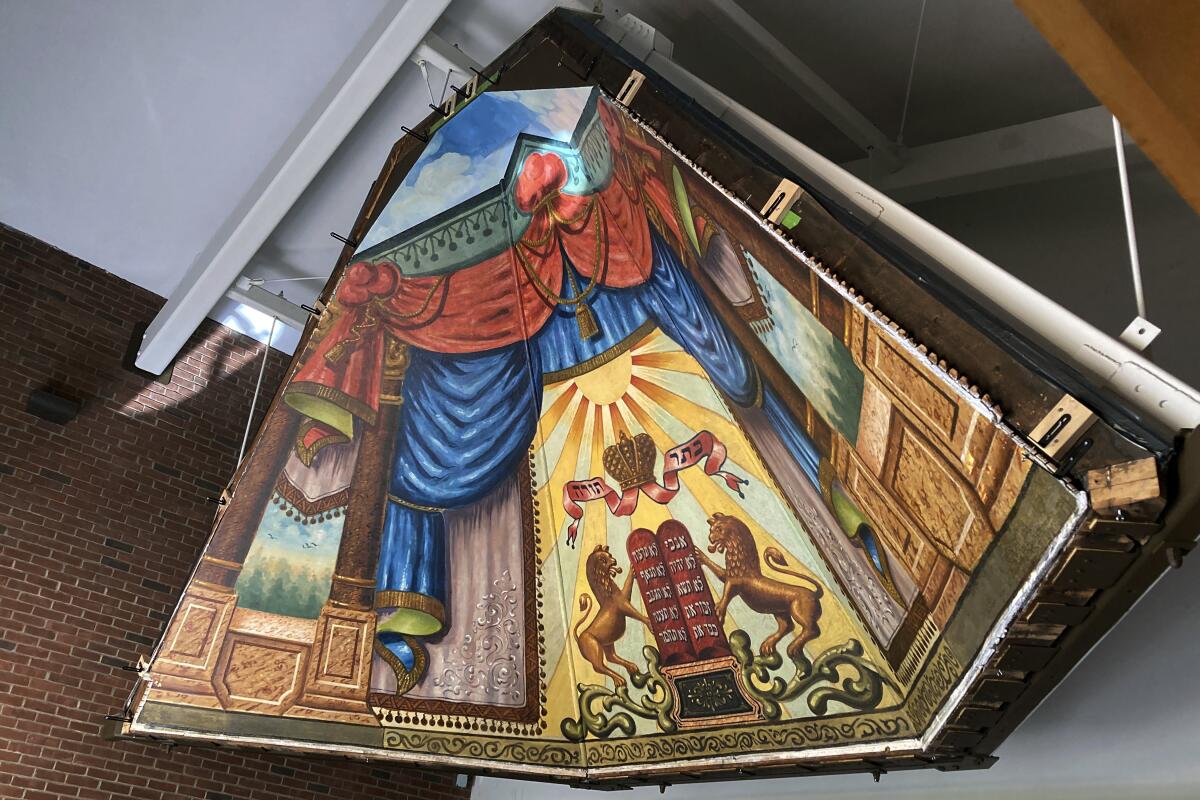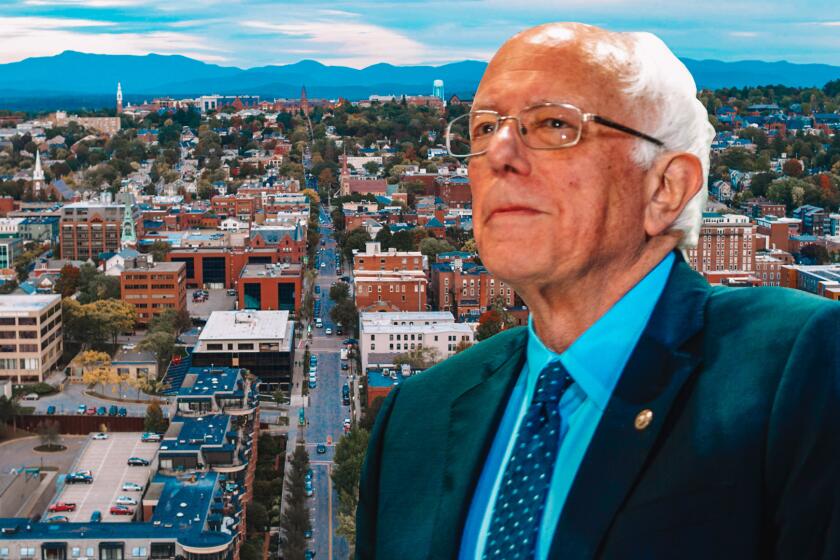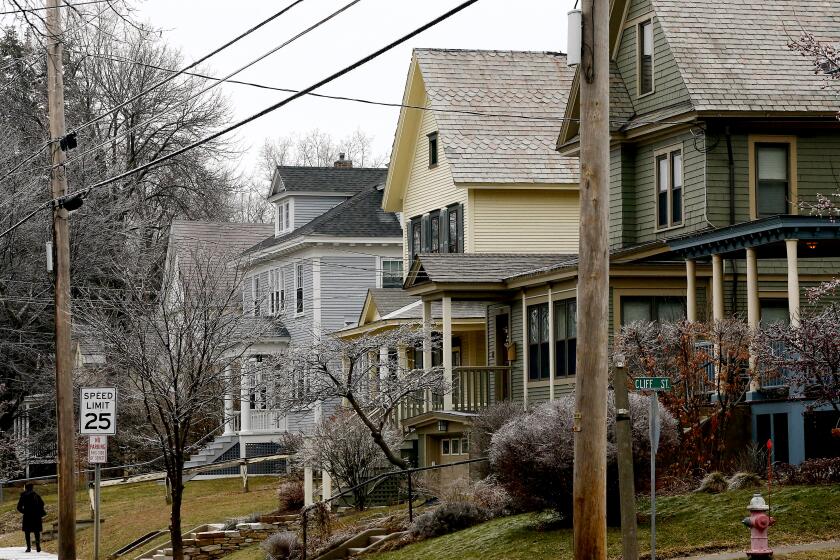A century-old Vermont synagogue mural, said to be unique in the U.S., is uncovered and restored

- Share via
BURLINGTON, Vt. — A mural that was painted in a Vermont synagogue more than 100 years ago by a Lithuanian immigrant, then hidden behind a wall for years, has been termed a rare piece of art and has been painstakingly moved and restored.
The large, colorful triptych created by sign painter Ben Zion Black in 1910 shows the Ten Commandments with a lion on both sides, the sun beaming down, and columns and rich curtains at the borders. Now known as the “Lost Mural,” it’s a rare representation of a kind of art that graced wooden synagogues in Europe that were largely destroyed during the Holocaust, experts say.
“When I learned about the mural and what it is and the story behind the artist, I was completely amazed, and there is nothing like this elsewhere in this country,” said Josh Perelman, chief curator and director of exhibitions and interpretation at the Weitzman National Museum of American Jewish History in Philadelphia.
It’s a representation of a style that was present throughout Europe, but Perelman said he has never heard of anyone bringing that style to the United States.
“It makes it both a treasure and also a significant work, both in American Jewish religious life and the world of art in this country,” he said.
Black, who was a musician, playwright and poet as well as a sign-maker, decorated the inside of what was then the Chai Adam Synagogue in 1910 in a Jewish neighborhood in Burlington, Vt., known as Little Jerusalem. He painted the triptych — the Lost Mural — in the apse of the building, as well as other murals in the synagogue’s interior.
Burlington shaped Sanders as Sanders shaped Burlington, so much so that it’s hard to consider one without the other.
The synagogue closed in 1939 when it merged with another one, Ohavi Zedek, and the original building went on to have other uses, including as a carpet store, according to the Lost Mural website.
When the building was being turned into apartments in 1986, Ohavi Zedek archivist Aaron Goldberg and a fellow synagogue member got the owner to install a wall in front of the mural, according to the website. Black’s two daughters donated money to have archival photographs taken of the art, but it was unclear at the time whether the mural could be saved, Goldberg said.
More than 20 years later, the wall board was cut away, and photographs were taken and sent to museums around the country and world asking what should be done with the artwork, Goldberg said.
“The universal consensus then was that we needed to do everything we could and take all the possible measures to take out the original mural because of its uniqueness, because it really is a symbol for perhaps thousands of murals and this type of painting that were lost in Eastern Europe and Western Europe,” Goldberg said.
Vermont’s largest city and more than 30 social justice, education and health organizations have declared systemic racism a public health emergency.
The plaster was in poor condition, and paint was flaking off in many sections. The plaster was stabilized, and a conservator worked to reattach the paint. Then a temporary structure was built so that the building’s roof could be removed, the mural’s laths reinforced, and the artwork encased in a metal frame for the move in 2015 by crane and truck to the current Ohavi Zedek Synagogue.
In its new home, conservators restored damaged sections of paint and cleaned the entire mural, revealing its original vibrant color and detail. Paint was also matched and added where it had fallen off. That work took place this and last year, during the COVID-19 pandemic, when the building was largely unused.
About $1 million was raised for the project through donations from local, state, national and international donors. The Lost Mural Project, an independent secular nonprofit organization, is still seeking donations to replicate the green corridors on the original painting that did not survive, said Goldberg, its president.
The renewed mural was unveiled this summer, and tours are ongoing.
News Alerts
Get breaking news, investigations, analysis and more signature journalism from the Los Angeles Times in your inbox.
You may occasionally receive promotional content from the Los Angeles Times.
Senior Rabbi Amy Small saw the beauty of the restoration step by step, whenever she came to the office or sanctuary, which she said was a reminder of how significant the mural is.
It’s significant not only to the Jewish community and the descendants of those early settlers of Burlington, but also to other immigrants in the U.S., which offered safety for Jewish and other families fleeing from many parts of the world, she said.
“It’s both a Jewish story and an American story,” Small said, as well as a “universal story.”
Another part of the Lost Mural story is the “magnificent, creative and devoted people who have nurtured its preservation and its re-presentation to the world,” Perelman said. “The Burlington community, the Burlington Jewish community, the state of Vermont, have been marvelous in their sense of the importance of this work of art and their commitment to bringing it back to view.”
More to Read
Sign up for Essential California
The most important California stories and recommendations in your inbox every morning.
You may occasionally receive promotional content from the Los Angeles Times.












